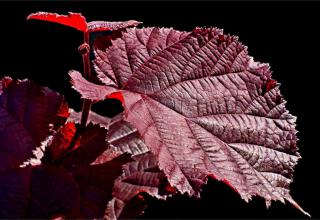

Purple hazel is a truly ornamental shrubby nut tree.
Purple Hazel facts, a summary
Name – Corylus maxima purpurea
Family – Betulaceae
Type – fruit shrub
Height – 13 to 20 feet (4 to 6 meters)
Exposure – full sun
Soil – ordinary, rather light
Foliage: deciduous – Flowering: spring – Harvest: fall
Growing this purple-leaf shrub is easy: care, pruning and harvesting must follow good practices if you want to have nice hazelnuts.

But you can also plant it in any other season of the year, as long as you avoid high temperatures in summer and frost spells in winter.
It is critical that you plant 2 different varieties together to ensure fertilization and fruit-bearing.
No pruning is needed, except for the first years to speed growth up.
If you wish to reduce the branches or even out the hazel tree’s bearing, wait for the blooming to end.
The hazelnuts are ready to be harvested when the fruit detaches from the branch and falls to the ground.

Set this tree up as a standalone, in a shrub bed, or add it to your hedge.
Hazelnuts are harvested in fall.
Even if the ornamental value of this tree is what stands out, its fruits still are edible.
It’s one of the most remarkable red-leaved shrubs.
Among other purple trees, you’ll find a striking variety of katsura, the ‘Red Fox’ katsura. There are also varieties of Cotinus (smoke tree) that have stunning violet hues.
Of course, the regular hazelnut tree has the same fruit and planting needs as purple filbert.
Read also:
Remove suckers that grow from the base often.